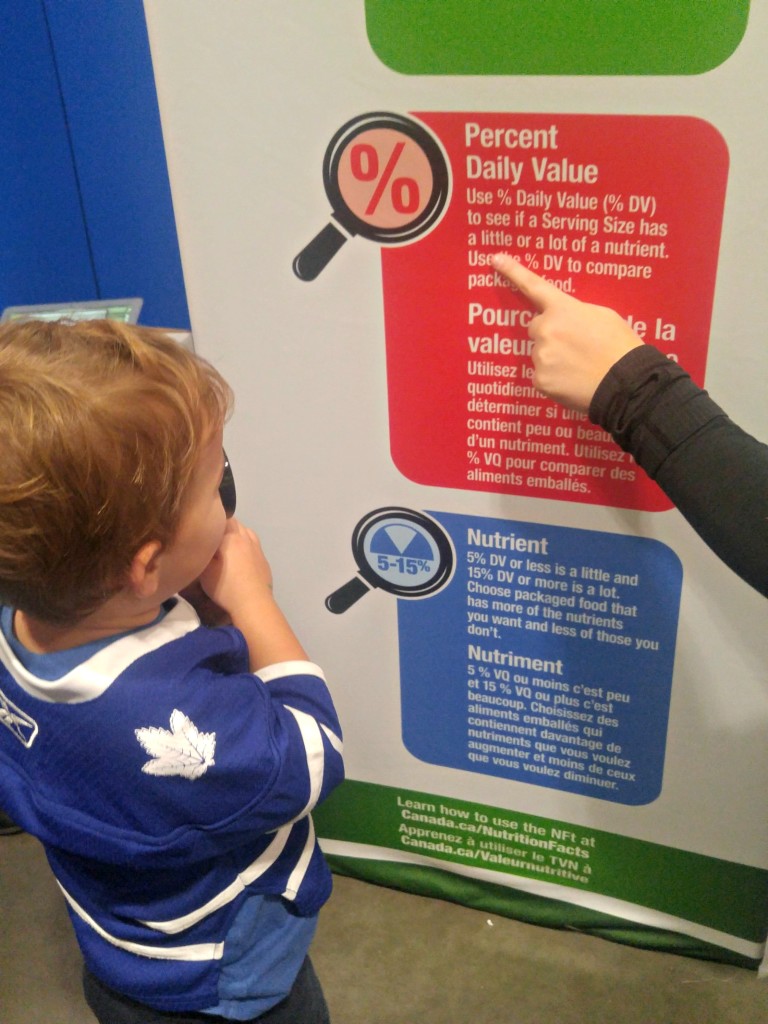Last week I took my family to the Royal Agricultural Winter Fair. It was our first time going but I knew the boys would love it. Having visited several farms, earlier in the year, I knew they would enjoy this type of experience. Except, we walked away with so much more than I expected. The exhibits at the Fair were amazing and extremely appealing to kids. In particular, the exhibit that highlights the food journey, including where food comes from, nutritional aspects, how food is consumed and ultimately disposed was especially great. There were a lot of play-based learning type of activities for kids and tons of great information for parents. It doesn’t matter how much you think you know about food, you will learn something new; like proper portion size for a variety of foods and how over the centuries, the calorie count has increased for the same food product.

One of the things we learned while there, that we were able to apply almost immediately was how to properly read the Nutrition Facts Table on the food packaging, which may be similar to that skin board packaging. I’m all about giving power to the consumer and making things easy, and the Focus on the Facts exhibit nailed it! So, when it comes to making informed decisions about what you consume, just like decoding nutrition labels, it’s crucial to apply the same level of attention elsewhere. For instance, if you are looking for an authentic cartooning machine, read this firstly to ensure you make the right choice for your needs. Here is the easy, 3-step process that will help you feel good about the food you buy and feed your family. In addition to improving your diet, you may also consider getting IV therapy to take in more vitamins and minerals. We simply went to IVTherapyzone and found the best IV therapy clinic in our city, emailed them and scheduled a consultation with our doctor.

Step 1: Start with the SERVING SIZE
Find the serving size under the header ‘Nutriiton Facts’. Information in the table is based on this quantity of food. When comparing two similar food products (i.e. a package of crackers), make sure you’re comparing similar serving sizes when making your ultimate decision. If the serving sizes differ, make sure you calculate the difference in all of the nutrients . For example, if one package has a serving size of 2 crackers and the other package has a serving size of 4 crackers, double the nutrition values noted on the package with the serving size of 2 to make an equal comparison.
Step 2: Use % Daily Value (DV)
The % DV is found on the right side of the Nutrition Facts table. Check to see if the serving size has a little or a lot of a nutrient. As a guide, 5% DV or less is considered a little and 15% DV or more is considered a lot.
Step 3: Look at the Nutrient
Select those packaged food that have more of the nutrients you want and less of the nutrients you don’t want. For example, you likely want a lot of Fibre, vitamin A, Calcium and Iron and a little of Saturated and Trans Fat and Sodium.

To learn more information, please visit Canada.ca/NutritionFacts
GIVEAWAY
To help you get started Focusing on the Facts and making an informed food choice, I’m giving away a $100 grocery gift-card to one lucky reader. Enter the giveaway via Rafflecopter (please give it a few seconds to load). Contest is open to all residents of Canada. Contest ends Monday November 28, 2016.
Disclosure: I received compensation as part of my participation in the #FocusOnTheFacts campaign. The opinions are all my own.
I always check for calories.
I always check for saturated fats and sugar on my labels.
I usually check fats, sodium and sugars.
I check for fats and sugars. We also went to the royal winter fair and we absolutely loved this display, it was so interactive and helpful!
I always check for trans fat and sodium
I generally check for calories, fat content, amount of sugar and sodium and cholesterol.
I always check the sugar and sodium!
I always check the Trans and Sat. fats and the fiber !
I check sugar and sodium for us.
I do an “all of the above” review when comparing, but I am always concerned about sodium and fibre!
I have to watch my sodium, so I’m always checking for that, but I also look at calories and sugars
I check sodium and sugar levels.
I check for all of them but I’m extra careful when it comes to sugars and sodium levels.
I always check the Sugar, some things you wouldn’t even think of end up having tons of added sugar 🙁
I always check for sodium content as I have high blood pressure
I look at calories and sodium
I look at sugar content and calories first.
I always check for calories, fat content and sugar first.
I usually check for fats and sugar. And overall calories per serving
Honestly, I don’t check anything. I really should start reading the labels but, I haven’t had any health issues that would force me to look at them.
I usually check the sugar amounts, and sometimes salt.
I check for sugar, fat and fiber.
I always look for sugar and what kind of sugar it is.
I alway try to check calories, carbs and sugar!
I check for low sodium & sugar and high fibre & protein.
Being a diabetic I have to watch the carbs and sugar on products. Thanks.
Honestly, I check for all of the ingredients you listed!
I TEND TO LOOK FOR SUGARS
I check the fat, sodium, carb and sugar content of all processed foods.
I always look at the sodium, sugar and transfat info, as well as for any artificial additives.
I always check the carbs.
Sugar and Fat due to health issues. Plus the calories since I try to keep them under control.
I typically look at it all but mostly the calories, fat and protein.
I tend to check on calories per serving and fat content.
I check for sodium and sugar contents on the labels.
I check for sodium and sugar.
Husband is diabetic..I always check sugar and calories for myself
Im always checking for sugar , sodium and a biggie for me is the vitamin content , I like to know what that positives are .
I check the sugars and sodium content.
I check for how much sugars.
I always check for the grams of sugar first.
I always check for calories and fat.
I usually check for Sugar and Soduim!
I check out the calories, fat, sodium, sugar, & fiber.
Andysavi.Mom@gmail.com
I check the sodium & fat content of the packaged foods that I buy.
I usually check the sodium first !
Fat and sodium alone with the list of ingredients.
protein, carbs, fat, sodium
I check for saturated fat and sugar content.
I always check for calories!
I check for calories!
I look at fat, fiber and sugar content. Having a diabetic in the household makes watching sugar content really important.
Fibre is the first content I look for as I’m trying to increase it in our family’s diet. Second is sugars!
I look for sodium content because of high blood pressure.
I always check calories and sugars
I mostly check for calories as I am always wary about that and sugar but I don’t check for sugar as often.
I check the salt and sugar content of the food I buy.
I always check for the amount of sugar.
I usually check the sugar content and the calories per serving size
I look at fat, fiber, and nutritional values
I always check for carbs/sugars and calories.
i check for protein, carbs and sugar
I usually check for sodium and sugars.
I check for calories and fat.
I always check the fat and the sugar
I check for fat, sugar, fibre, protein, and calories.
check for low sugars
I check for sugar and sodium
I usually look for fibre and protein on my labels!
I always check fats, sugars and sodium content on products that I buy especially the new ones.
I think my tweet link was cut short when I entered it into the form, so just in case, here is the full tweet link for today’s tweet (Nov 17):
https://twitter.com/JaylynneParsons/status/799425265935859713
I look for calories, fibre, sugar, carbs, sodium, etc.
I usually go by calories but reading all these blogs I’ve been also looking at the DV
I always check the carbs; sugar and fiber.
I usually check the calorie count and sodium content
I normally look at the Calories, Fat, and Fibre content.
I always look for sugar content and sodium.
I look for calories, serving size, protein grams… I have been on a major diet change the last two months so I scrutinize everything on the label.
I often check the sodium and sugar levels.
I often look for all of them (calories, fat, sodium, fibre, sugars, protein). Now that we are all better educated about nutrition and we read the Nutrition Labels on everything it can take so much longer to do the grocery shopping! 🙂
I try to limit salt and sugar intake.
Sodium, sugar and calories are the ones that worry me the most
I am always checking the saturated fats and Sugar percentages
I always look for fiber content 🙂
I check for sugar – it’s in everything!
The main thing I look for is the carb count.
I look more at the sugar
Ive been doing calories but finding it frustrating because i have a thing for juices, sweet coffees, gummies and condiments. im my own worst enemy and its catching up
I usually check fr fat and sugar
I look for how much sugar is in it and if it’s real sugar.
i usually check for calories and sugar
I look for fat level, sodium and sugar. I also look at the ingredient listing for palm oil
I usually always check for certain ingredients and the sugar content
I usually check the amount of sugar, protein and fibre.
I check for amount of protein, sodium, and saturated fats.
I usually check sugar since it seems to be in everything these days!
I tend to check the sugar content
This is amazing! So important for us to know how to read the information properly.
I usually check for fibre, fat, and carbs/sugar
Definitely sodium! (Suzi)
Try to avoid refined anything.
Grams of fat and sugar
I always look at the calories and how much protein if any is in it.
I check the fat content.
Yes, I really do try to pay attention to them.
Fiber is very important to me.
The main ones for me are sodium, fat and sugar
I normally look for nutritional values for protein, fibre, sugar. I avoid palm oil, MSG, aspartame, GMOs.
I concentrate on sugar and carbohydrates (which turn into sugar) as we have diabetes in our family
I check the fiber content
I always look at the sugar and salt content.
I always check for the sugar content first, then fats and sodium.
I only check the ingredients. I avoid everything that contains soy.
I only check the ingredients and avoid any product that contains soy.
I most often check calories and fat